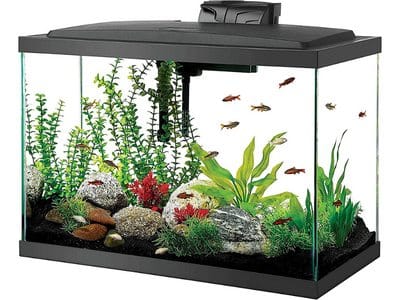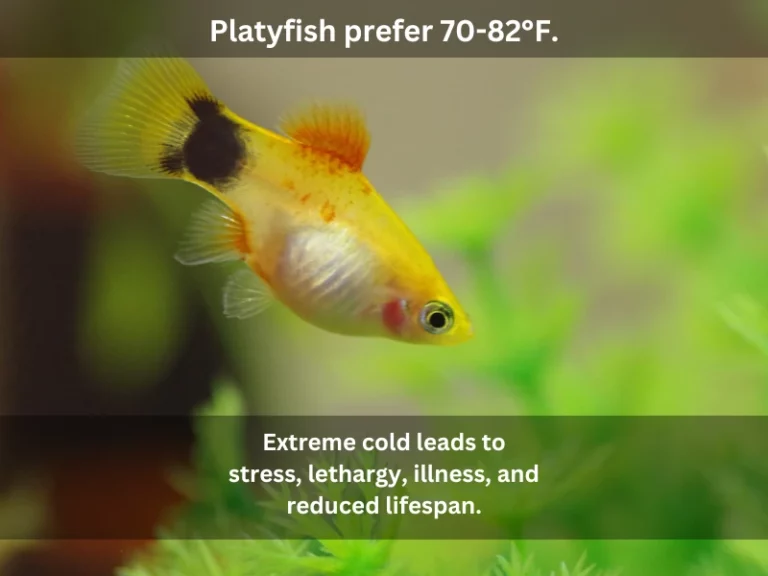Here are the tank size recommendations for platy fish:
| Tank size (gallons) | Number of platyfish |
| 5 gallons | 3 |
| 10 gallons | 6 |
| 20 gallons | 12 |
| 30 gallons | 21 |
| 40 gallons | 27 |
| 50 gallons | 33 |
The tank size you will use for platies depends on your purpose of keeping the fish. If you’re breeding them, I recommend using a larger tank and a proper combination of male and female platies stocked in it. But what is the minimum tank size for platy fish?
It is recommended to keep a group of at least 3 to 6 platies together. Stock 3 platies in a 5-gallon tank, 6 in a 10-gallon tank, 12 in 20 gallons, 21 in 30 gallons, and 27 in 40 gallons. Maintain a ratio of 2 female platyfish to 1 male to reduce stress on the females.
You can avoid fry in your fish tank by keeping only male platies. Otherwise, I’d recommend a male-to-female platyfish ratio of 1:2 or 1:3.
Tank Size Recommendation for Platies

The right tank size for platies depends on the number and size of platies you want to keep, their social behavior, and their activity level. A tank will also carry more dwarf platies than big platies.
The rule of thumb is to have one gallon for every inch of a platyfish. A three-inch adult platyfish needs three gallons of water for maximum comfort. Ten platies will need about 30 gallons. Platies are very active and require adequate space to eat, play, and hide.
I recommend keeping platies in multiples of three for optimal social behavior. Similarly, the smallest recommended platyfish tank size is five gallons. However, I find that the bigger the aquarium, the healthier and happier the platies. The problem is that as tank size increases, maintenance difficulty also increases significantly.
Here are some tank sizes and the number of platyfish to keep in each:
| Tank size | Number of female + male platyfish |
| 5 gallons | 2 females and 1 male |
| 10 gallons | 4 females and 2 males |
| 20 gallons | 8 females and 4 males |
| 30 gallons | 14 females and 7 males |
| 40 gallons | 18 females and 9 males |
| 50 gallons | 22 females and 11 males |
How many platies in a 5-gallon tank?
Although a five-gallon tank is small for bigger fish, it is the minimum tank size for platies. Keep three platies in a five-gallon tank. These could be all males, all females, or mixed platies.
However, I don’t recommend mixing male and female platies in a five-gallon tank because it is not convenient for breeding.
Most importantly, overcrowding five-gallon tanks with platies may cause poor filtration, pollute the water, and kill your platies.
Despite the small size, a five-gallon tank is much easier to clean and maintain than a 50-gallon tank. After removing the platies and the water, wipe the inside of the tank with a paper towel. Avoid using soaps and chemicals to clean fish tanks.
RECOMMENDED: Read my guide on keeping platyfish in a 10-gallon tank here.
10 gallons
A 10-gallon freshwater aquarium can comfortably house 4-6 platy fish. When stocking platies, it’s recommended to have at least 3 females per male to prevent aggression. Plenty of plants and hiding spots will also help curb aggressive behavior in a small community tank.
Therefore, a 10-gallon tank is enough for 4 female and 2 male platyfish. Remove any fry from the tank soon enough to prevent overcrowding and aggression.
20-gallon tank
It is recommended to keep a maximum of 12 platies in a 20-gallon tank. You can mix male and female platies in the same tank, but remember to have 2 females for every male to reduce aggression in the tank.
Therefore, a 20-gallon tank should accommodate 8 female and 4 male platyfish.

Aqueon Aquarium Starter Kit with LED Lighting
My recommendation is this 20-gallon tank that comes as a complete starter kit. It has everything you need to set up a successful aquarium.
Female platies are a few inches bigger than male platies. If you want more platies in a 20-gallon tank, keep males alone. I’ve found that the same tank can carry more male platies than female ones.
Pro tip: I don’t recommend a 20-gallon aquarium for breeding platies because it will overcrowd quite fast. The minimum tank size for breeding platies is 20 gallons (110 liters).
A 20-gallon tank is great for beginners because it is relatively easy to clean and maintain and will need fewer substrates and decorations than larger tanks. It is ideal to start with if you’re on a budget.
Unlike some fish that don’t require a filter, platies need one and frequent water changes. Change the water weekly or biweekly. But cleaning your 20-gallon tank once a month is acceptable if you have an efficient filter. However, avoid changing the water all at once.
30-gallon tank
You can keep up to 21 platies in a 30-gallon tank. If you want your platies to breed, put seven males and 14 females in the 30-gallon tank. It will not require frequent cleaning and changing of water as a 5-gallon tank does because the water is not polluted quickly.
However, a 30-gallon tank is slightly heavy and should not be placed on weak surfaces. Also, proper care and maintenance are necessary.
30 gallons provide adequate space for adding plenty of aquarium plants, rocks, filters, and other decorative pieces to your aquarium.
Pro tip: Do not change 100% of the water at once as it can cause an imbalance in temperatures and bacteria needed for the survival of the fish. Remove and change only a small fraction of the water every two to three weeks.
40-gallon tank
A 40-gallon fish tank is large enough to make your platies happy as if they were in their natural environment.
Not only is the water temperature and pH stable for the fish, but a 40-gallon tank also gives platies a variety of hiding, playing, and breeding spots in the aquarium. To avoid overcrowding a 40-gallon tank, keep only 27 platies in it: nine males and 18 females.
Keep the large tank away from direct sunlight and traffic because too much light can heat the water and cause excessive algae growth, unless you’re stocking some mystery snails to feed on the algae in the tank.
While you can clean it every three weeks, a 40-gallon tank is deep and tedious to maintain since it holds many platies, and removing them can cause unnecessary stress or hurt to your fish during a water change.
Leave the platies inside the aquarium and change only 25% of the water at any given time.
50-gallon tank
A 50-gallon fish tank can not only house much fish but also allow for variety. For instance, I keep platies and guppies in my 50-gallon tank. Although I have just a handful of platies, you can keep as many as 33 platies in a 50-gallon tank. Using the 1:2 male-to-female ratio means 11 males and 22 female platies in the aquarium.
However, the larger the tank, the greater the maintenance costs. You will need lots of fish food, substrate, filters, lighting, and decorations for a 50-gallon tank. It is also cumbersome and fragile. The tank requires structural support at a strategic location in your home as you won’t move it very often.
In addition, aggressive fish may not trouble your platies in a 50-gallon tank as they would in a five or ten-gallon tank. It also looks great.
Proper care of your platies in a 50-gallon tank can increase their lifespans to two or three years. Keep a 50 gallon fish tank in your house’s East or North-East direction for auspiciousness.
Pro tip: Platies are prolific breeders. Females will give birth every four weeks, so only populate your tank with male and female platies if you plan to breed them. Otherwise, expect their population in the tank to grow exponentially and problems like male aggression in your tank.
Minimum tank size for platyfish
The minimum tank size for platyfish is five gallons. You can keep 3 platies in it: 2 females and 1 male. However, a five-gallon tank might not provide optimal conditions for the fish. For example, the water temperature in such a small tank can vary drastically and put your fish at risk.
Instead of going for a minimum five-gallon, I recommend that you use at least a ten-gallon tank for your platies.
You don’t have to put many fish in the tank. The fewer the platies in a giant aquarium, the healthier and happier they will become.
Unlike larger immovable fish tanks, smaller tanks are flexible and portable. You can change their locations within the house as often as you want. But due to the small tank sizes, you should change the water weekly to enhance filtration and reduce pollution.
Pro tip: Platies are great to keep in a general community tank with tank mates like gouramis, mollies, and zebra Daniels. However, ensure you have a big tank with plenty of plants and keep your platies with other fish that don’t need heated water.
How many platies should be kept together?
It is good to keep a minimum of 3 platyfish together (2 females and 1 male). However, if the tank is 20 gallons or larger, stock 6 or more fish to encourage activity and playfulness.
The key is maintaining a ratio of 1 male for every 2 female platies to reduce aggression since the males will always stress the females with mating attempts.
Signs your aquarium is overcrowded with platies
Here are some signs that your aquarium is overcrowded with platyfish:
Stunted platies
Overcrowding affects platies at a cellular level. The stress can manifest as slow and stunted growth in your platies. In addition, overcrowding compromises their immune system and increases the fish’s vulnerability to diseases that stunt their growth.
Reduced activity
If you exceed the tank’s platy-carrying capacity, you will notice your platies gasping for air, breathing laboriously, or swimming sluggishly. That is because the oxygen concentration in the aquarium is depleted due to overcrowding.
Discolored water
Platies are very active fish. Overcrowded platies poop and disturb the water and decayed food materials, changing the water to yellow or brown. Although tannins from driftwood might clear over time, excessively discolored water shows that your platies are overcrowded.
Increased mortality of your platies
Increased competition for food and mates causes stunted growth in platies and makes them lethargic. If your platies have shorter life spans, perhaps the tank is overcrowded.
Should tank size increase with other tank mates?
Increasing your tank size is the way to go if you plan on introducing other tank mates to your platies. First, not all tank mates are friendly to platies.
Therefore, a larger tank is essential in reducing aggression e.g., if you’re keeping bettas and platies together. Secondly, a large tank allows you to create biodiversity. You can experiment with new set-ups, decorations, and other fish species like guppies.
References
- Duke University. Aquarium Equipment: What’s Essential and What’s Not?
- Purdue University. Aquatic Science Resource Manual





